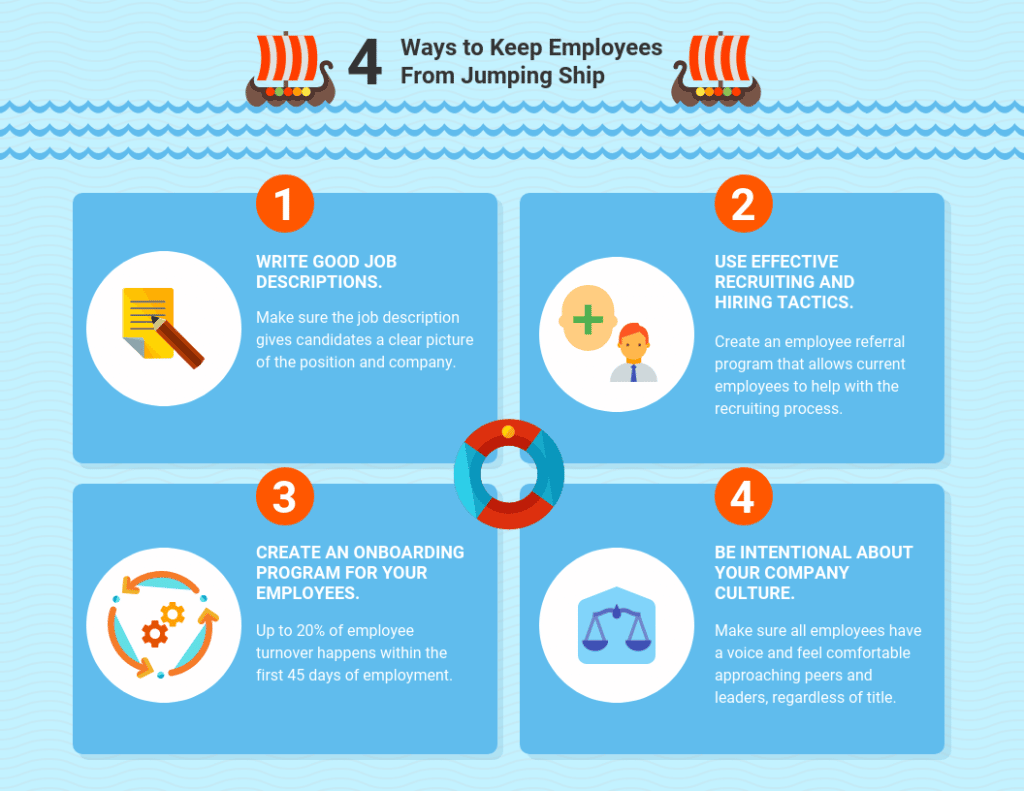A bad onboarding experience leads to poor retention – and this can be costly. New hires, no matter how fit they are, will be likelier to look for new opportunities quickly if they experience a negative onboarding experience. And this can be tough to recover from whether you’re a small or large company.
Onboarding is your first opportunity to introduce your organization’s culture to a new hire, and improving it gradually can lead to a positive change. Strengthening your onboarding process improves employee retention by 82% and productivity 70%.
The most crucial period for a new employee is their first year, as they’re 10X likely to quit at this period when compared to those who make it at least five years. It is one of the most significant events that an organization wants and needs to avoid especially a high-attrition or churn rate in which people leave the organization for certain reasons, poor organization culture included.
The cost of a bad onboarding process is high – and this includes being a primary cause of turnover, costing a company between 100% and 300% of the employee’s total salary. New hires make up their minds within the first 6 months of employment – whether they’d stay or look for another opportunity.
What better way to make it right from the get-go than before an employee starts with your company? Use a realistic job preview (RJP).
What Is Realistic Job Preview?
Conveying the good and bad aspects of a job to a prospective employee, an RJP is a recruiting tool used by HR professionals to give prospective employees a clear picture of what the job entails, including the work duties, environment, and expectation. It will help employees decide if they’re to proceed with the rest of the application process or if they’re a good match, and it can help human resources departments reduce turnover.
RJPs allow the prospective candidates to decide using the right information – about a company’s culture (e.g. flexibility, communication). It helps them make the right decision whether they’re to accept a job offer should it had been offered to them.
This prevents them from ending up disappointed. For example, they find out something they dislike and so they change their mind, such as the HR manager wants the new hire to report at work daily from 9 A.M to 6 PM, but the employee wants more flexibility and work remotely.
But had expectations been communicated from the beginning, the time and resources of both parties (employer and prospective candidate) could have been saved.
No sugar coating – and remaining as realistic as it should be, an RJP shows exactly what a candidate should expect on the job – a realistic view of it, nothing more and nothing less. It doesn’t just describe the duties and responsibilities or the paper work involved on a daily basis but also what a typical day in the job would FEEL and LOOK like.
This lets your candidates assess the suitability of the job for what they expect from it and helps them have a feel if what they’re looking for or expecting from an employer, for instance, will be met should they accept the job.

The RJP makes the hiring process a two-way street from the beginning
Using this hiring tool in the recruitment process is an effective and efficient way of reducing the cost of hiring new employees who might be quitting within the first six months of employment should their expectations were not met.
Realistic Job Preview Benefits and Purpose
Turnover reduction: Represent the job well and clear from the job description and the new hire’s introduction to the team, work environment, and the entire onboarding process.
Give employees a bird’s eye view of what the job they’re signing up for entails – and make them feel happier and more fulfilled that – “Yes, I made the right decision.” An accurate job preview is one of the foundations of a successful hire, and later, you won’t have to say, “Oh, I made the wrong hiring decision.”
An RJP removes the element of surprise and saves money at the same time, and it doesn’t only attract talents but actually retain them. This ultimately saves your organization money and resources, which it should be spending to find a replacement sooner.
The realistic job preview gives both the company and the prospective candidate a better look at the job where they can find a mutual interest. This job description can significantly reduce turnover rates because new hires understand the job from the very beginning. Think of the RJP as a psychological contract between the employer and the new hire.

Less stress and frustration: There is nothing quite more frustrating for an HR professional than it is to deal with a new hire that feels unhappy and frustrated with the new job alongside the work environment and organizational culture.
For instance, a hiring manager asks a new hire for more work than what is agreed on. This can lead to frustration and unhappiness – and burnout.
[Burnout sabotages retention. Forty-six percent of HR leaders reveal that it’s one of the primary causes of annual workforce turnover, from 20% to 50%, and 10% of them point out it leads to over 50% of workforce turnover annually.]
More happiness: Happier employees make for a happier workplace, leading to less frustration and more productivity. They’re also less likely to quit and are more creative, and one way to have these people in your company is to be honest and transparent – an RJP does that for you.
[You must also make honesty a part of your organizational culture because it will also help you understand your people’s concern through feedback and effective communication. Be transparent in addressing a particular issue and include your people in the big picture in addressing it.]
And what follows with happier employees? It’s happier human resource people (Hooray!). How? Less employee frustration means a fewer number of complaints to deal with daily and a wiser use of resources of your human resources team. Consequently, they can spend more of their time and energy on other things you need for operation. It also means a more efficient and productive HR team.
Employee promotion system: Aside from a higher salary, promotion is another thing that can excite and motivate employees – because it gives them a career growth opportunity. Who wouldn’t want it?
A promotion system is the ascension of employees from a lower to a higher rank – and this includes not just a position raise but also a raise in salary and increase in benefits. An RJP can clearly communicate this to employees. A few types of employee promotion system include vertical promotion, horizontal promotion, open and closed promotion, and dry promotion.
Promotion, after all, is one of the reasons that an employee is working hard and it is a normal expectation from them when accepting a job. By being transparent about this in the RJP, you’re giving a prospective candidate how promotions work in your organization.
For example, take note that 40% of millennials expects to receive a job promotion every one or two years, while the youngest generation was likelier to say that bonuses and raises aside from promotions should be given at least once a year.

How to create an RJP?
There are multiple elements involved in a realistic job preview that you must consider when creating yours. We’ve highlighted them in the following.
Organizational vision
It describes your organization’s purpose and what it strives for and includes what it wants to achieve. This vision can communicate the values of your organization and its commitment to achieving the goals. But then, having a clear vision may not be enough.
You need to communicate that vision to your members, and this is different than communicating concrete ideas. To communicate that vision to other people, the leader of the organization should convert any abstractions to concrete ideas – and one way to do it is through living that vision.
This means that the leader should also demonstrate and embody those values in the actions that he/she is taking – leading by example. After all, employees pay close to the behavior of the leader to understand the organizational vision.
Organizational mission
Also called a mission statement, an organizational mission includes a brief and broad statement about your organizational goals and ways that it intends to achieve those goals. A mission statement addresses what your organization offers to your customers and how you want to serve them as well as other stakeholders, investors, and employees.
Other mission statements can also include an explanation of the principles that your organization believes in and that it wants to abide by. This mission can also help in guiding the actions and decisions of your organization. In short, it addresses your organization’s purpose. It is about the objectives of your company and ways you’re planning to achieve them. In the end, a mission can help your organization move forward with its activities.
Job description
Also called job profiles or job specifications, this document outlines the requirements of the job and is also one of the most essential in the recruitment process. It states the skills, responsibilities, and job requirements needed to perform a role and covers how well that success will be measured because it will be used in performance evaluations later.
This document is recruitment tools explaining the function, duties, tasks, and responsibilities of a position, and it clearly details who the person to perform the job is along with information on how that will be completed, among others.
JDs are used for different purposes, including when evaluating performance reviews and establishing titles. They’re also used in determining salary levels and developing accommodation controls.
The recruitment tool is used in career planning, in developing legal requirements for compliance, and for offering training exercise. A supervisor also uses a JD as a resource guide for evaluating an employee’s job performance – ensuring that he/she meets the job expectations.
The JD is considered as the most important part of the realistic job preview because it paints what a candidate, again, should expect from the job.
Training opportunities
Not overlooking the importance of training opportunities is a key secret to keeping top talents because these can motivate employees. In the RJP, you can clearly show how you can help your employees develop and grow as professionals – and this is a great way of developing an engaged and loyal team that at the same time are eager to learn and productive.
Giving your people development and training opportunities can show your sincere intention of helping your workforce develop professionally. These opportunities are beneficial investments that can also work to your advantage because you can develop quality and efficient employees. This will directly affect your bottom line, too.
Summing up the numerous benefits of employee training opportunities include employee engagement, motivation, and satisfaction, and provide them with the needed skills to better do their job. These opportunities also develop a more diverse skill set to help with your workforce’s flexibility and adaptability to the changes in the industry. Such development opportunities also help you develop quality employees because they allow your people to be the best that they can be in their roles.
Training opportunities, in the realistic job preview, are useful tools in attracting top talents and eventually helping you improve your company’s bottom line and profits.

Development opportunities
Companies invest in employee training and development because attracting the right people with the right skills isn’t easy to achieve, but when achieved, you must keep your top talents. It is why you must clearly communicate employee development goals and ways when creating your RJP.
More often than not, development opportunities envision to building a workforce that can support your organizational mission, while also striving hard to develop engaged people. But then, employee development isn’t only about giving seminars to employees but it should also encourage and motivate employees and must be center around your organization’s short- and long-term goals.
It must also be available and accessible to employees and cater to their needs based on their tenure and level. By focusing on development opportunities and including those in your long-term strategy can improve performance and employee engagement.
Rewards and benefits
In your organization’s job preview, include the benefits, compensation, and rewards that will clearly show what are in joining your organization. This component outlines the total rewards – including the different employee benefits, development opportunities, and work-life balance.
Rewards and benefits can be either or both monetary and non-monetary. These can include monetary incentives that can improve worker engagement and performance. These monetary incentives can reward employees for productivity, for instance. Not just in the form of cash, but these incentives can include profit-sharing plans, stock options, bonuses, and paid time off.
These benefits can also include semi-annual and annual bonuses, like end-of-year and mid-year rewards. Such monetary rewards can motivate and push people to work harder and give their best.
There are also non-monetary opportunities that reward employee performance through different perks, such as training opportunities and flexible work hours. Such rewards allow workers to develop themselves to learn new skills.
Promotion system
A promotion can increase an employee’s morale and sense of accomplishment. Those who receive recognition for their accomplishments exhibit positive work attitude and behavior and tend to have an increased morale.
This employee advancing system helps meet an employee expectation because it is one of their goals for working hard. It also reduces attrition or the rate in which an employee quits their job, and it improves productivity and motivation.
When employees are offered an opportunity to grow, they’re less likely to leave the company for another that offers a better promotion opportunity. Nevertheless, employee promotion is an essential element to include in the rewards program of a company. And ultimately, it can improve employee engagement, motivation, and retention.
Implementing a realistic job preview
Now, more than ever, it is easier to give prospective candidates a clear overview of what it would look like to work with and for your organization. With the advancements of technology, organizations can display their expectations and culture. Here are some great examples to inspire you in creating your next RJP.
Employee testimonial video
Statistics had it that prospective candidates are likelier to trust information if it comes from someone working in the company than from the company itself because they want to know the truth – both the good and bad aspects of the job. For example, this testimonial can feature an employee who shares his/her experience with the company and the things that make him stay.
Assessment Style Quiz
An online quiz is a cost-effective way of developing an RJP especially in the stage wherein you’re still lowering the number of candidates from a higher number that initially applied. This method in RJP allows you to give a clear overview of what the job entails and lets you assess if the candidate matches the job requirements.
360-degree video
This is a creative RJP that allows applicants to get a clear picture of what it’s like to work in the company. If you already have an employee video, this immersive video can further help the prospective employee learn more about the job because it also gives them the opportunity to see the work environment where they’ll be working.
Interactive simulation
It makes information in a typical RJP more digestible and engaging for prospective candidates. You can use this to implement an RJP in combination with the others mentioned earlier. This method allows candidates to immerse in the job from the perspective of an employee.
Brochure
This is the conventional way of implementing an RJP that allows prospective candidates to know more about the job and the organization in its entirety. A text brochure allows you to highlight as many aspects of a position or job and clearly defines everything in writing. This prevents miscommunication with employees ending up frustrated and allows the candidates to refer to the brochure later should they wish to review something about the job.
Final Thoughts
What is realistic job preview? It shows a candidate exactly what he/she’s signing for before joining an organization’s workforce or signing a job offer should it be made. It prevents employee frustration and unhappiness and increases retention rate, while it also saves human resource teams’ energy, resources, and time in dealing with frustrated employees and replacing employees that quit within the first six months.
At the end of the day, it is all about being transparent and honest of both the good and bad aspects of a job – and this can make the big difference. Develop and offer this self-assessment tool to prospective candidates to help them make an informed decision as to join your company or not and assess whether their expectations of the job can be met. Ultimately, this can lead to a better employee experience that can go a long way.
